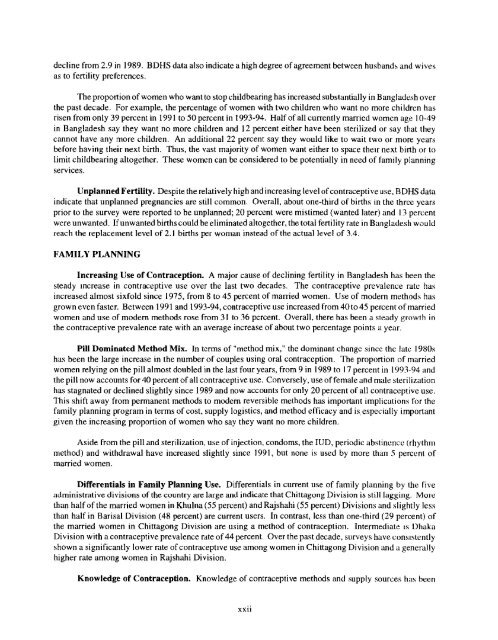Bangladesh 1993-1994 Demographic and Health ... - Measure DHS
Bangladesh 1993-1994 Demographic and Health ... - Measure DHS
Bangladesh 1993-1994 Demographic and Health ... - Measure DHS
- No tags were found...
You also want an ePaper? Increase the reach of your titles
YUMPU automatically turns print PDFs into web optimized ePapers that Google loves.
decline from 2.9 in 1989. B<strong>DHS</strong> data also indicate a high degree of agreement between husb<strong>and</strong>s <strong>and</strong> wivesas to fertility preferences.The proportion of women who want to stop childbearing has increased substantially in <strong>Bangladesh</strong> overthe past decade. For example, the percentage of women with two children who want no more children hasrisen from only 39 percent in 1991 to 50 percent in <strong>1993</strong>-94. Half of all currently married women age 10-49in <strong>Bangladesh</strong> say they want no more children <strong>and</strong> 12 percent either have been sterilized or say that theycannot have any more children. An additional 22 percent say they would like to wait two or more yearsbefore having their next birth. Thus, the vast majority of women want either to space their next birth or tolimit childbearing altogether. These women can be considered to be potentially in need of family planningservices.Unplanned Fertility. Despite the relatively high <strong>and</strong> increasing level of contraceptive use, B<strong>DHS</strong> dataindicate that unplanned pregnancies are still common. Overall, about one-third of births in the three yearsprior to the survey were reported to be unplanned; 20 percent were mistimed (wanted later) <strong>and</strong> 13 percentwere unwanted. If unwanted births could be eliminated altogether, the total fertility rate in <strong>Bangladesh</strong> wouldreach the replacement level of 2.1 births per woman instead of the actual level of 3.4.FAMILY PLANNINGIncreasing Use of Contraception. A major cause of declining fertility in <strong>Bangladesh</strong> has been thesteady increase in contraceptive use over the last two decades. The contraceptive prevalence rate hasincreased almost sixfold since 1975, from 8 to 45 percent of married women. Use of modem methods hasgrown even faster. Between 1991 <strong>and</strong> <strong>1993</strong>-94, contraceptive use increased from 40 to 45 percent of marriedwomen <strong>and</strong> use of modem methods rose from 31 to 36 percent. Overall, there has been a steady growth inthe contraceptive prevalence rate with an average increase of about two percentage points a year.Pill Dominated Method Mix. In terms of "method mix," the dominant change since the late 1980shas been the large increase in the number of couples using oral contraception. The proportion of marriedwomen relying on the pill almost doubled in the last four years, from 9 in 1989 to 17 percent in <strong>1993</strong>-94 <strong>and</strong>the pill now accounts for40 percent of all contraceptive use. Conversely, use of female <strong>and</strong> male sterilizationhas stagnated or declined slightly since 1989 <strong>and</strong> now accounts for only 20 percent of all contraceptive use.This shift away from permanent methods to modem reversible methods has important implications for thefamily planning program in terms of cost, supply logistics, <strong>and</strong> method efficacy <strong>and</strong> is especially importantgiven the increasing proportion of women who say they want no more children.Aside from the pill <strong>and</strong> sterilization, use of injection, condoms, the IUD, periodic abstinence (rhythmmethod) <strong>and</strong> withdrawal have increased slightly since 1991, but none is used by more than 5 percent ofmarried women.Differentials in Family Planning Use. Differentials in current use of family planning by the fiveadministrative divisions of the country are large <strong>and</strong> indicate that Chittagong Division is still lagging. Morethan half of the married women in Khulna (55 percent) <strong>and</strong> Rajshahi (55 percent) Divisions <strong>and</strong> slightly lessthan half in Barisal Division (48 percent) are current users. In contrast, less than one-third (29 percent) ofthe married women in Chittagong Division are using a method of contraception. Intermediate ~s DhakaDivision with a contraceptive prevalence rate of 44 percent. Over the past decade, surveys have consistentlyshown a significantly lower rate of contraceptwe use among women in Chittagong Division <strong>and</strong> a generallyhigher rate among women in Rajshahi Division.Knowledge of Contraception. Knowledge of contraceptive methods <strong>and</strong> supply sources has beenxxii








![Obtaining Informed Consent for HIV Testing [QRS4] - Measure DHS](https://img.yumpu.com/49850117/1/190x245/obtaining-informed-consent-for-hiv-testing-qrs4-measure-dhs.jpg?quality=85)







